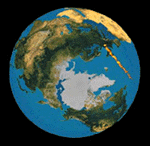|
ASTRONOMY
RETURN OF THE SPACE SNOWBALLS
Did a blizzard of icy comets
give the earth its oceans?
It was the kind of news Chicken Little would surely understand: on May 28 Louis A. Frank of the University of Iowa announced that miniature comets (each about the size of a house) are slamming into the earth's atmosphere at a staggering rate of some 40,000 a day. This pummeling is far beyond anything astronomers had envisioned based on the known components of the solar system. "If it is true, this is a very important result," comments Heinrich Holland of Harvard University.
But is it true? Frank made a similar announcement 11 years ago, drawing on views of the earth's atmosphere made with the Dynamics Explorer 1 satellite. Those pictures contained strange dark spots that Frank interpreted as "holes" in the glow of the upper atmosphere caused by the arrival of low-density iceballs--tiny cousins of ordinary comets. A number of researchers promptly raised stinging scientific objections to his small-comet hypothesis, however, and suggested that the holes were nothing more exotic than instrumental artifacts. Under a barrage of criticism, Frank's ideas faded from view.
 | ULTRAVIOLET STREAK,
superimposed on the visible
earth, may be the wreckage of
a small comet. | | Image: NASA Goddard Space Flight Center; University of Iowa |
Now Frank is back, armed with improved data from the recent POLAR satellite and a big publicity buildup as well. At the meeting of the American Geophysical Union where Frank delivered his results, "there were so many lights from the photographers that the audience couldn't see my slides," he says. Several former doubters are voicing a more open attitude. "I believe the POLAR evidence--the holes are real," says Thomas M. Donahue of the University of Michigan, a longtime skeptic.
Frank has released some fresh details about the physical nature of the small comets; he vividly describes them as icy objects so tenuous (about 1/20 the density of water) that "you could walk up to one and put your arm right through it." Otherwise, his remarkable claims remain much the same as before. Small comets add about one inch (2.5 centimeters) of water every 10,000 years, he believes, enough to fill the oceans over the lifetime of the earth. And carbon compounds in these fluff balls, gently delivered to the earth, "may well have nurtured the development of life on our planet," Frank thinks.
Despite the increased respect for Frank's observations, many of the objections to his conclusions remain the same as well. "The new data show that there is some effect going on," Feldman agrees, "but there is a real credibility problem with Frank's explanation." In 1991 Alexander J. Dessler of Rice University published an exhaustive list of problems , "any one of which would be fatal to the idea of small comets," he says. The problems are still there.
Perhaps most damning is the evidence from the sensitive seismometers that Apollo astronauts placed on the moon. These instruments did not detect any signs of a hailstorm of small comets. Citing work by Thomas Ahrens of the California Institute of Technology, Frank explains that his comets are so diffuse that they would not create much of a seismic jolt. But Ahrens himself doubts that solution, noting that low-density objects "are actually a good way to make a seismic signal," because they couple effectively with the surface.
There is good evidence that interplanetary space contains little water or water-derived hydrogen atoms, so the small comets would need improbably effective surface coverings that prevent any water molecules from escaping. Yet even normal comets, which can leak enough material to make conspicuous tails, contain rocky or metallic grains; if the small comets had any significant amount of solid material, they would produce brilliant showers of shooting stars in the earth's atmosphere. "To reasonable scientific certainty, Frank's ideas just can't be right," Dessler declares.
Still, the POLAR images have convinced many scientists that something odd is going on. "The challenge now is not to point out the problems with Frank's model but to develop an interpretation that respects the other constraints," Donahue says. Frank stands firm, unfazed by his many doubters. "It is human nature," he reflects. "There are still some people who don't believe in continental drift." --Corey S. Powell
|